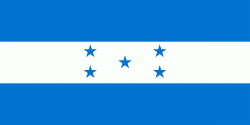Guanaja
Guanaja is one of the Bay Islands of Honduras and is in the Caribbean. It is about 70 km off the north coast of Honduras, and 12 km from the island of Roatan. One of the cays off Guanaja, also called Guanaja or Bonacca or Low Cay (or just simply, The Cay), is near the main island, and contains most of the approximately 5,538 people who live in Guanaja. The densely populated cay has been described as the Venice of Honduras because of the waterways that run through it. The other two main settlements on Guanaja are Mangrove Bight and Savannah Bight. Smaller settlements includes Pelican Reef, East End and North East Bight.
The primary source of income for the islanders is fishing and shrimping. Tourism is confined to a handful of small resorts that cater to divers, snorkelers and adventure travellers. The island's warm, clear waters support an extensive coral reef that is part of the Mesoamerican Barrier Reef and second only to the Great Barrier Reef off the coasts of Australia. Currently, there is still access to fresh water on Guanaja, and several waterfalls can be seen. Since 2021 the entire island and its cays have been designated as a protected Ramsar site.
Christopher Columbus landed on Guanaja on his fourth voyage in 1502. Notably, this was the first time he came across cacao, which is the core of chocolate. He landed on Soldado Beach on the north side of the island. In later years Cayman Islanders settled in the Bay Islands, which explains the diffusion of Spanish and English language.
Homer Hickam was one of the first scuba explorers of Guanaja, first visiting in 1973. Along with a team of other scuba explorers, he extensively mapped the reef system around the island for sport divers. He still owns property on the northeast end of the island.
In late October 1998, most of the buildings and homes on the island were destroyed by Hurricane Mitch. The islanders have since rebuilt, and although there are still repercussions to the economy from Mitch, tourism has been recovering. The majority of the mangrove and pine forests, which were destroyed as a direct consequence of the passage of the hurricane sweeping across the island for two days, are slowly making a comeback.
Guanaja was also known as:
* Caguamara (1600)
* Isla Pinos (1600)
* Guanaca (1601)
* Guanaia (1657)
The primary source of income for the islanders is fishing and shrimping. Tourism is confined to a handful of small resorts that cater to divers, snorkelers and adventure travellers. The island's warm, clear waters support an extensive coral reef that is part of the Mesoamerican Barrier Reef and second only to the Great Barrier Reef off the coasts of Australia. Currently, there is still access to fresh water on Guanaja, and several waterfalls can be seen. Since 2021 the entire island and its cays have been designated as a protected Ramsar site.
Christopher Columbus landed on Guanaja on his fourth voyage in 1502. Notably, this was the first time he came across cacao, which is the core of chocolate. He landed on Soldado Beach on the north side of the island. In later years Cayman Islanders settled in the Bay Islands, which explains the diffusion of Spanish and English language.
Homer Hickam was one of the first scuba explorers of Guanaja, first visiting in 1973. Along with a team of other scuba explorers, he extensively mapped the reef system around the island for sport divers. He still owns property on the northeast end of the island.
In late October 1998, most of the buildings and homes on the island were destroyed by Hurricane Mitch. The islanders have since rebuilt, and although there are still repercussions to the economy from Mitch, tourism has been recovering. The majority of the mangrove and pine forests, which were destroyed as a direct consequence of the passage of the hurricane sweeping across the island for two days, are slowly making a comeback.
Guanaja was also known as:
* Caguamara (1600)
* Isla Pinos (1600)
* Guanaca (1601)
* Guanaia (1657)
Map - Guanaja
Map
Country - Honduras
 |
 |
| Flag of Honduras | |
Honduras was home to several important Mesoamerican cultures, most notably the Maya, before the Spanish colonization in the sixteenth century. The Spanish introduced Catholicism and the now predominant Spanish language, along with numerous customs that have blended with the indigenous culture. Honduras became independent in 1821 and has since been a republic, although it has consistently endured much social strife and political instability, and remains one of the poorest countries in the Western Hemisphere. In 1960, the northern part of what was the Mosquito Coast was transferred from Nicaragua to Honduras by the International Court of Justice.
Currency / Language
| ISO | Currency | Symbol | Significant figures |
|---|---|---|---|
| HNL | Honduran lempira | L | 2 |
| ISO | Language |
|---|---|
| ES | Spanish language |















